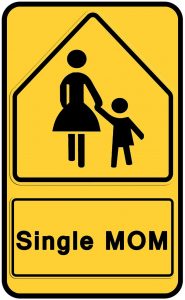As a young child in the early 1990s, my family had all the markers of a middle-class lifestyle. Even though neither of my parents had a bachelor’s degree, my father had a good job as an operator at the local power plant, we lived in the suburbs in a new development, and my mother stayed home with my sister and me. However, that all changed when I was eight years old and my parents divorced. As in most cases, my mother took primary custody and moved us back to her hometown in rural North Carolina. Even with help from family members and checks from my father, we struggled. After nearly a decade out of the labor force and technologically illiterate, good jobs were hard to come by for my mom. Using Pell grants, she went back to school, excelling in community college while cleaning houses part-time. However, when the time came to transfer to a regional university, an hour away, the commute and technological divide became too much, and she dropped out after only a few weeks.
My family’s experiences with single motherhood are far from unique. It has been well documented that living in a single mother household substantially increases the likelihood of being poor. In the United States, 46.7% of children in single mother households were poor in 2019. Yet, this is not just an American issue. In practically all Western democracies, children in single mother households are more likely to be poor than children living with two parents. At the same time, this risk of poverty has changed over time and varies across countries. In particular, I wondered what more could have been done to help women like my mother and children like me.
This is exactly the question investigated in my recent article. Certainly, I am not the first to consider why single mother families are so prone to poverty and what can be done to address it. However, previous research has typically focused on only one, or maybe two, possible explanations. These include family characteristics, such as whether single motherhood is caused by divorce, death, or never getting married, and work characteristics, including whether single mothers are working and whether she is working part- or full-time. When it comes to macro-level factors, economic conditions have been of interest, building on the classic expectation that a rising tide lifts all boats, as well as social policy generosity, looking at the provision of maternity leave or government provided childcare. In my research, I bring together and test all four.
In my analyses, I do not find much support for the economic arguments; a stronger economy is not necessarily the best way to address poverty for children of single mothers. When it comes to family characteristics, relative to having a mother who has never been married, having a divorced mother means a slightly smaller chance of poverty, while having a widowed mother means the lowest chance of poverty among the three groups. But if the goal is to find solutions, these findings do not provide much help. Certainly, a policy that recommends your husband dying in lieu of divorce is not advisable or ethical, nor is one that encourages marrying to divorce instead of remaining unmarried.
Work characteristics affect poverty in ways most would expect: working full-time and having a high level of education is best. Unfortunately, this is not a practical expectation for single mothers, particularly in the United States. As illustrated by my own anecdotal experience and as demonstrated by previous research, going back to school and/or working full-time is not possible for many single mothers. Childcare is expensive, higher education is demanding, and the persistence of the motherhood penalty, in which mothers experience labor market discrimination, means the types of jobs available to single mothers may still not be enough to lift them out of poverty.
Policy solutions, however, are tangible and effective. The most impactful policy solution I find is family allowances. The more a country spends on family allowances, the bigger the effect on child poverty. This proves true not just for children in single mother households but also for children living with two parents. If a country increases its spending one standard deviation, the chances of poverty for the typical child in a poor single mother household go down 10 percentage points. Rather than a 50/50 chance of poverty, she would have a 40% chance. As mentioned, children in two parent families would also benefit from this spending, but children of single mothers benefit more. While not completely eliminating the single mother penalty, spending on child allowances can substantially reduce it, bringing the poverty gap to around 6 percentage points at the highest levels of spending.
This evidence gives substantial support for the potential of government spending on family allowances to address the high levels of poverty among children of single mothers. Similarly, this spending would benefit not just children in single mother households, but in two parent households as well. However, particularly in the United States, cash benefits, especially for the poor and able-bodied has not been popular. Therefore, implementation of such policies may encounter resistance. Yet, it is my hope that given this evidence and the fact that family allowances have the potential to benefit many children, those in positions of influence can push to improve the lives of children and families.
Amie Bostic is an Assistant Professor of Sociology at the University of Texas Rio Grande Valley. Her research focuses on social policy, poverty, and public opinion. You can find her other recent publications here, here, and here. She is on Twitter @amie_bostic.


Comments